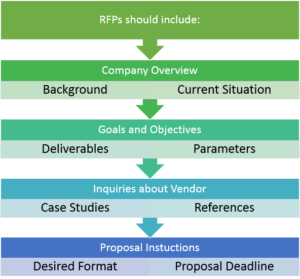Tips for Writing an Effective Request for Proposal
When you are ready to contract an outside vendor for your IT consulting needs, a Request for Proposal (RFP) is often the first means of communication in what will ultimately become a long-term relationship. Set this budding relationship up for success by distributing an RFP that accurately and efficiently expresses your needs, expectations, and priorities for the upcoming project. The process of constructing a winning RFP may seem a bit daunting, especially if you are new to game, so we have compiled a few tips that will help you stay on the right track.
Narrow vendor pool by beginning with a Request for Information (RFI)
Because it is challenging to compare a large number of responses effectively, conduct a preliminary round of vetting by sending potential vendors RFIs. With an RFI, you can evaluate vendors based on relevant experience, history, and stability — before they commit to developing entire proposals. This allows you to eliminate non-compatible options without requiring a significant time commitment on either your part or the part of the vendor. Once you have selected (no more than a handful of) potential vendors, you can construct a targeted RFP that will help you to distinguish between them on a more substantial level. Make sure vendors know they are on your short list – moving beyond the preliminary round of elimination presents success as a real possibility, incentivizing them to develop a stellar proposal.
Learn from experiences of others
In large financial operations, such as the circumstances that motivate the development of an RFP, it is important to take a wide array of insights and perspectives into account to guarantee the process runs as smoothly as possible. Before beginning to compose your RFP, it can be very helpful to look at a sampling of RFPs created by other companies – in similar and different fields of business – both to make sure that you are aware of what information vendors expect to find in an RFP and that no vital information is lacking. This principle is also useful internally — involving multiple people in the process of writing the RFP will both help to make sure all of your bases are covered and that the text does not allow multiple, incorrect interpretations. Finally, when you are narrowing down your vendors, check their references so that you can gain a second hand perspective into what a potential partnership may be like. The more information you obtain and perspectives you explore, the better equipped you will be to make the right decision.

Determine evaluation criteria before you begin
Because the purpose of this RFP is to find the best match for your company, you need to define from the outset what an ideal match would look like — and how you intend to rate potential vendors. Once these criteria have been established, they should be used as a guidepost throughout the entire writing process. This way you can be certain that all of the information included in your RFP is relevant to your decision-making. Communicate to vendors which characteristics you are most interested in so that they can focus their proposals on content that will impact your selection.
Be clear and detailed in your request
If potential vendors do not understand what it is that you are asking for, you are in a position to receive generic responses intended to cover all possible bases. The key to communicating successfully with your RFP is to focus on clarity, organization, and detail. Provide explicit, detailed instructions on how and when you would like to receive proposals — this way it will be easier to make direct comparisons between vendor responses. Emphasize your priorities, objectives, and requirements so that vendors will know what to focus on in their proposals, preventing them from responding vaguely after getting lost in a labyrinth of irrelevant information. Organize your requirements into easy to follow categories (such as functional, non-functional, and technical) so that vendors will understand how resources are to be allotted. Make sure your questions are specific to avoid indirect or rhetoric-heavy responses.
Focus on information that will influence your decision
Similar to using your evaluation criteria to guide your writing process, limiting your questions to information that is relevant to your decision-making will help you to distinguish between potential candidates efficiently and effectively. The goal of this RFP is to provide a basis for you to decide between vendors, so prioritize the information that is most important in coming to a resolution. Simpler questions make it easier to compare vendors directly. Use your time efficiently by asking about past projects that would have required similar solutions and by requesting case studies and references. Assign homework, such as requesting a code review, to obtain firsthand insight into a company’s technical experience and preferences.
At RTS Labs, we are happy to receive RFPs, especially those which are constructed in ways that allow us to develop our proposals effectively. When you win, we win — and the first step to a successful project is a well constructed RFP.